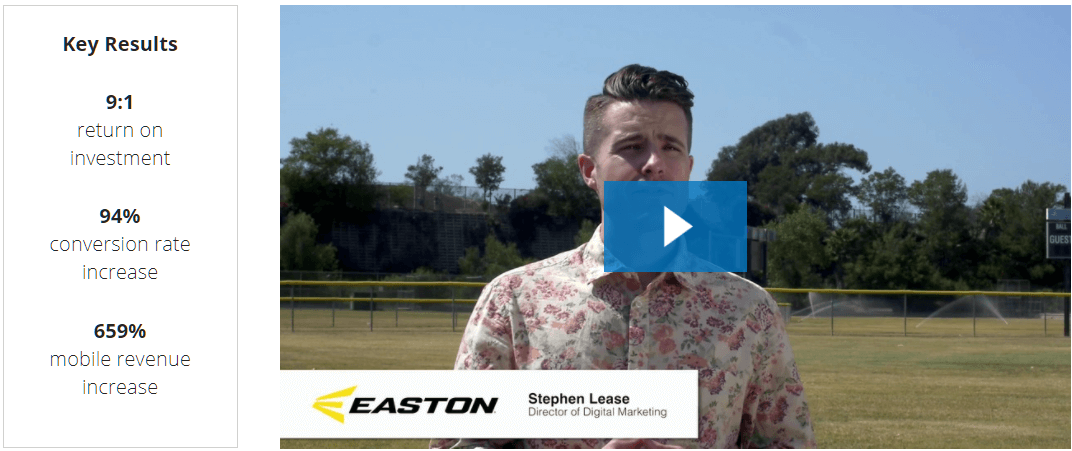
How to Multiply Your PPC ROI
CRO and PPC go hand-in-hand. The more of your visitors who convert from prospect to buyer, the greater your return on investment.
In this article, let’s look at how it can be entirely possible for you to get your PPC ad campaigns back in the black… relatively fast.
Before focusing on conversion rate optimization, Easton Sports was getting $4.50 in return for every dollar of digital marketing spend. That’s a decent ROI, but Easton knew more was possible.
After enlisting The Good to help with conversion rate optimization, Easton’s ROI doubled. They were soon getting $9 back for each dollar invested. That might seem too good to be true, but it’s a typical story.
Many companies are able to realize even higher returns than that with a structured CRO program. Many others, however, give up on PPC before ever considering the other side of the PPC return on investment equation.
We’ve seen ecommerce VP’s throw in the towel on PPC after working on their ads to bring cost-per-click down and fine-tune the target audience. With those things done and ads STILL costing more than they’re bringing in, it’s easy to assume that a legitimate PPC ROI isn’t possible for your niche.
Those who come to that conclusion completely ignore the second side of the equation: the conversion rate.
There are two ways to make a budget work: reduce expenses or boost income. When net sales revenue pushes above the PPC ROI average, you’re on your way to cultivating a winner.
On the ad side, the goal is to spend less per click. On the CRO side, the goal is to sell more.
If you’ve found a way to turn a dollar into fifty cents, you’ll eventually go broke. If you’ve found a way to turn one dollar into two dollars, keep doing it. But don’t stop there. Figure out how to leverage CRO to turn that one dollar into four, or five, or twenty.
If you’ve found a way to turn one dollar into two dollars, keep doing it. But don’t stop there. Share on XNever stop improving.
Multiply your PPC ROI – Consider this example
Let’s say, for example, that you have a fashion brand. You think your target audience is primarily 18 to 24-year-old female college students, so you naturally invest the lion’s share of your
to reach that segment.
After introducing CRO tools and tactics to collect and analyze the data, however, you discover that 35 to 40-something professional women spend significantly more on each purchase with you. Not only that, but the professional group comes back to shop four times more frequently than the student group.
What should you do?
CRO says you should optimize around what’s working best. In this case, you should explore how to serve your more mature demographic better.
You wouldn’t believe how often companies put their efforts into grooming the audience they think they have (or want to have), while ignoring the segment that comprises their actual best customers.
Don’t ask the shopper to change for you. A quicker path to success is to change your business to the wants and needs of the shopper.
When you direct your PPC campaigns to the right audience, you’ll see your conversion rate climb. Increased conversions = increased profits = greater ROI.
ncreased conversions = increased profits = greater ROI. Share on XNOTE: There’s a difference between PPC ROI (return on investment) and PPC ROAS (return on ad spend). ROAS is a simple calculation that compares the cost of your ads to the sales generated by them. PPC ROI, however, looks at the ‘real’ cost of ads by factoring in other associated expenses. In common usage, though, the terms tend to be undifferentiated. At The Good, first we ensure a positive ROAS, then dig deeper to consider true ROI.
You can’t catch shark in a trout stream
Once you’ve firmly identified your most profitable audience segment, you can increase sales to that group by giving them more of what they want… and presented in the way they want it.
When you’re planning a fishing trip, you choose the best bait, and you head to where the fish you’re looking for are sure to be gathered. You present your ‘offer’ in the right place, at the right time, and in an attractive (to the fish) package.
You don’t have to complicate data-based marketing and conversion rate optimization much more than that. Determine your market niche, present exceptional offers at a price both of you can afford, and you’re in business.
Here’s a typical sequence we use to hone in on the preferences of the chosen audience:
- Conduct user tests with people who fit the profile
- Direct them to complete various activities on your website
- Analyze the results of those tests to find obstacles in the way of prospective buyers
From there, you can develop hypotheses about improvements that would remove those barriers for your target audience. You can then design A/B tests to see whether you are right. Each time you conduct and study the results of a test, you have new information that can inform your next test.
Are you perfect customers having trouble with your search configuration? Are your product filters confusing them? Are you providing insufficient sizing details on your product pages?
This and more are all things you can build tests around – then use those results to make improvements and test again.
Never stop testing. Never stop learning.
Multiply your PPC ROI – here’s how it happens
Do you clearly see why CRO and PPC go hand-in-hand? The old saying that “Sales is all in the numbers” is only partially true. Sales is also in the presentation. The more of your visitors who convert from prospect to buyer, the greater your return on investment. Don’t rely on numbers only to grow your business. Leverage those numbers with attention to CRO.
A short list of the ways CRO helps increase PPC ROI
- CRO helps PPC by making sure you’re pulling the most profitable traffic: Are you pursuing traffic from the wrong target audience? CRO can help you discover whether the audience you’re seeking is truly the most effective.
CRO helps PPC by making sure you’re pulling the most profitable traffic. Share on X - CRO can help you distribute your efforts to the most effective PPC channels: Are you splitting your budget evenly between high and low performing channels? Is your audience best reached through Facebook or by Google ads? CRO will help you determine which channels you should focus on and which channels you should explore taking a step back from.
- CRO allows you to zone in on your highest converting audiences. When you do that, you’ll see your conversion rate grow, and you’ll get a healthier return on ad spend.
- CRO is your marketing amplifier: We’ve applied this same logic to other marketing efforts, and it works across the board. Just like CRO amplifies your SEO, inbound, and outbound marketing, it will help you draw more revenue from your paid traffic efforts.
- CRO provides an exponential benefit: Imagine you began getting twice the return on your traffic spend. You could begin reinvesting some of that new profit back into additional conversion optimization and increase your ROI further. Essentially, the more you do CRO, the more revenue you can generate and reinvest. Over time this compounds your revenue like a retirement account.
At The Good, we’ve found a direct correlation between the intensity of testing and the intensity of results achieved.
Here’s how it works:

Multiply Your PPC ROI – Final Thoughts
Investing in CRO is a powerful way to get more from your paid traffic spend and drive benefits for your other marketing efforts as well.
We developed a calculator to show clients how increased conversion rates can impact their websites. It’s a good way to get the lights on.
Care to try our conversion calculator yourself? It’s online, it’s easy and quick to use… and it’s free. Here’s that link: CRO Benefits Calculator.
If you want to know where to begin with CRO just schedule a quick 15-minute call and we’ll show you the top three things costing you ecommerce sales.
Resources:
- What is CRO: Conversion Rate Optimization?
- How to Quickly Get Started with Ecommerce Optimization
- Conversion Rate Optimization Essentials: The Master Guide

About the Author
David Hoos
David Hoos is the former Director of Marketing at The Good and a trusted advisor to marketing experts.

